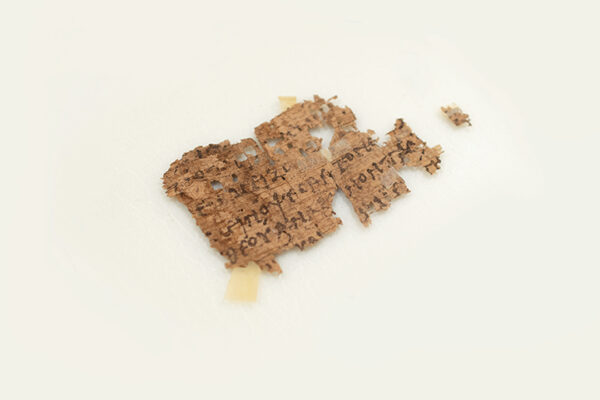AUSTIN, Texas — A credit-card-size fragment is all that survives of a manuscript scroll of the Gospel of John that was written in Greek circa A.D. 250-350. Once listed on eBay, it is now in the collection of the Harry Ransom Center at The University of Texas at Austin. It is on view to the public this fall.
Geoffrey S. Smith, an associate professor and director of UT’s Institute for the Study of Antiquity and Christian Origins in the Department of Religious Studies, first saw the eBay listing for the ancient fragment in 2015.
“I couldn’t let the papyrus slip into private hands,” Smith said. “This fragment has much to teach us about Christianity’s early centuries, and thanks to the generous support of a UT alum, the Willoughby Papyrus now has a permanent home in the Harry Ransom Center, where scholars and visitors alike can view and study this remarkable early Christian artifact.”
The acquisition of the Willoughby Papyrus was a collaboration between the Harry Ransom Center and the Institute for the Study of Antiquity and Christian Origins. The goal is to support new research in the history of religion, early Christianity, and the broader history of the book.
“By offering a unique window into the early transmission of Christian scripture, the Willoughby Papyrus strengthens the Ransom Center’s already wide-ranging and often deep holdings in the history of information technology, in the material ways humans have recorded their ideas and activities,” said Aaron T. Pratt, the Center’s Carl and Lily Pforzheimer Curator of Early Books and Manuscripts.
Students, scholars and the public will be able to consider the Willoughby Papyrus alongside an incredible variety of formats, from cuneiform tablets and other papyrus fragments to printed books and an ever-expanding array of born-digital files.
The Center hopes to carry out technical analysis of the papyrus and of the inks, which could provide evidence to support the A.D. 250-350 range. The fragment could allow scholars to better understand the relationships between the papyrus, the text from the Gospel of John, and an unidentified Christian text that is written on the other side.
“Now that the fragment is available at a public research institution, scholars will have opportunities to more fully evaluate the evidence already considered by Smith and offer their own interpretations,” Pratt said.
According to Smith, the Willoughby Papyrus is the only example of an early New Testament manuscript written on an unused papyrus scroll. Other fragments are almost always from a codex, the book in its modern format. In rare instances when New Testament texts do appear on scrolls, they were copied on the back of existing manuscripts. Not scrolls by design, they simply took the form of the books they repurposed.
“But the scribe of this papyrus seems to have wanted his copy of the Gospel of John to be a scroll,” Smith said. “Christians are well known to have been early adopters of the codex, even while Jews and non-Christian Romans seemed to prefer the scroll. But since the first followers of Jesus were not yet members of a distinct Christian religion, but members of a sect within Judaism, scholars surmise that there must have been a time—very early on—when New Testament writings were routinely written on scrolls.”
As the sole example of a Greek New Testament papyrus copied onto the front side of a scroll, the Willoughby Papyrus has much to reveal about Jewish and Christian relations in the ancient world and the history of the early Christian book, Smith said.
The fragment can be viewed alongside the Gutenberg Bible at the Ransom Center through Dec. 11. More details can be found at hrc.utexas.edu.




